Economic Analysis: Policies to Reduce Income Inequality in Hong Kong
VerifiedAdded on 2023/06/11
|15
|2792
|150
Essay
AI Summary
This essay provides an economic analysis of income inequality in Hong Kong, highlighting its causes, implications, and the policies implemented to address it. It begins by introducing the rising income inequality in Hong Kong, evidenced by the increasing Gini coefficient, and its impact on housing affordability. The essay then delves into the economic concepts and models, particularly the Gini coefficient and Lorenz curve, to measure and visualize income disparity. Key causes of income inequality are identified, including demographic composition, low pay-scales, emigration, and underinvestment in education. The implications of this inequality are explored, focusing on the housing market and the increasing house prices. The essay further examines government policies aimed at reducing income inequality, such as increasing the minimum wage and providing public housing. It concludes by emphasizing that despite being a dominant economy, Hong Kong faces economic challenges due to acute income inequality and housing affordability issues, while also noting that the demand for public housing remains higher than the supply.

Paraphrase This Document
Need a fresh take? Get an instant paraphrase of this document with our AI Paraphraser
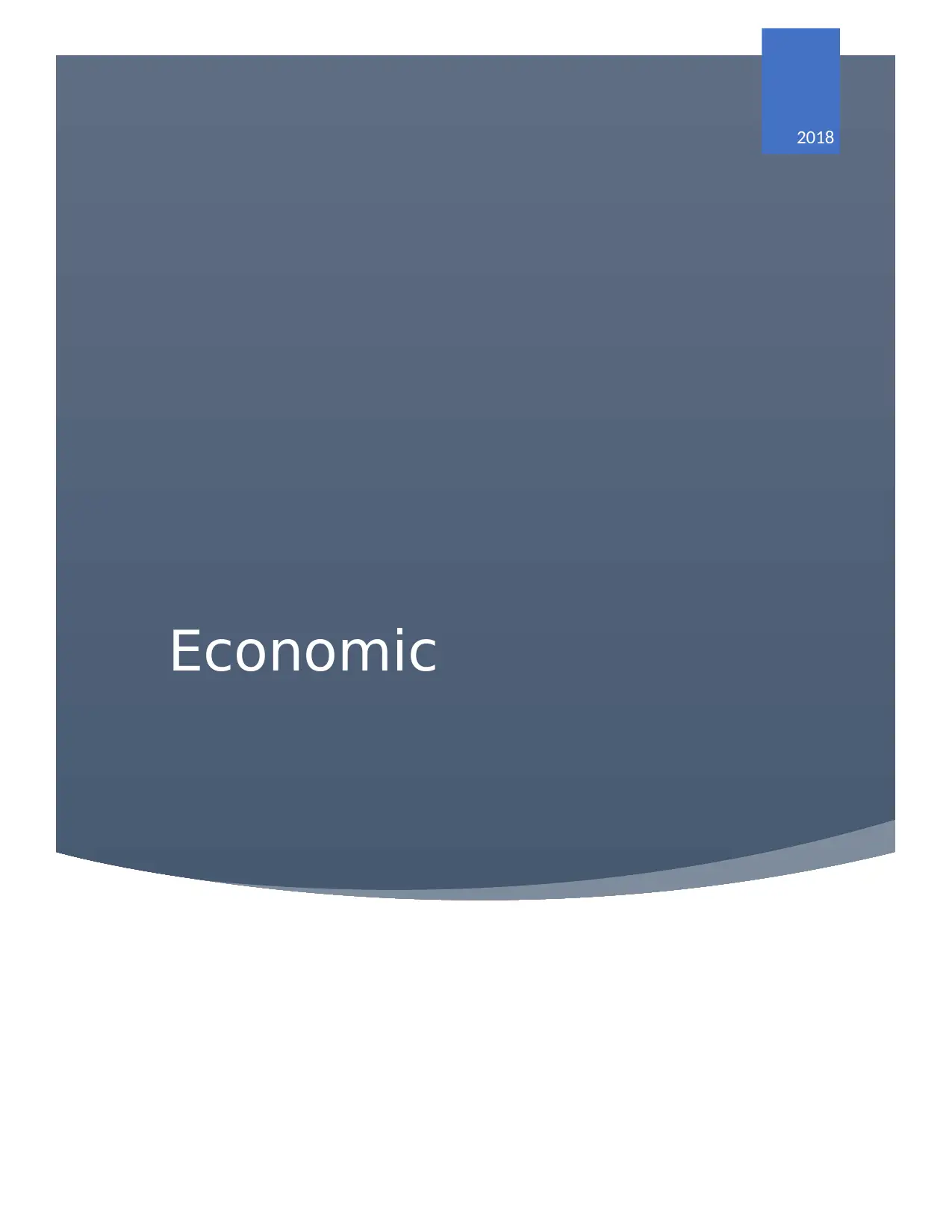
Economic
2018
2018
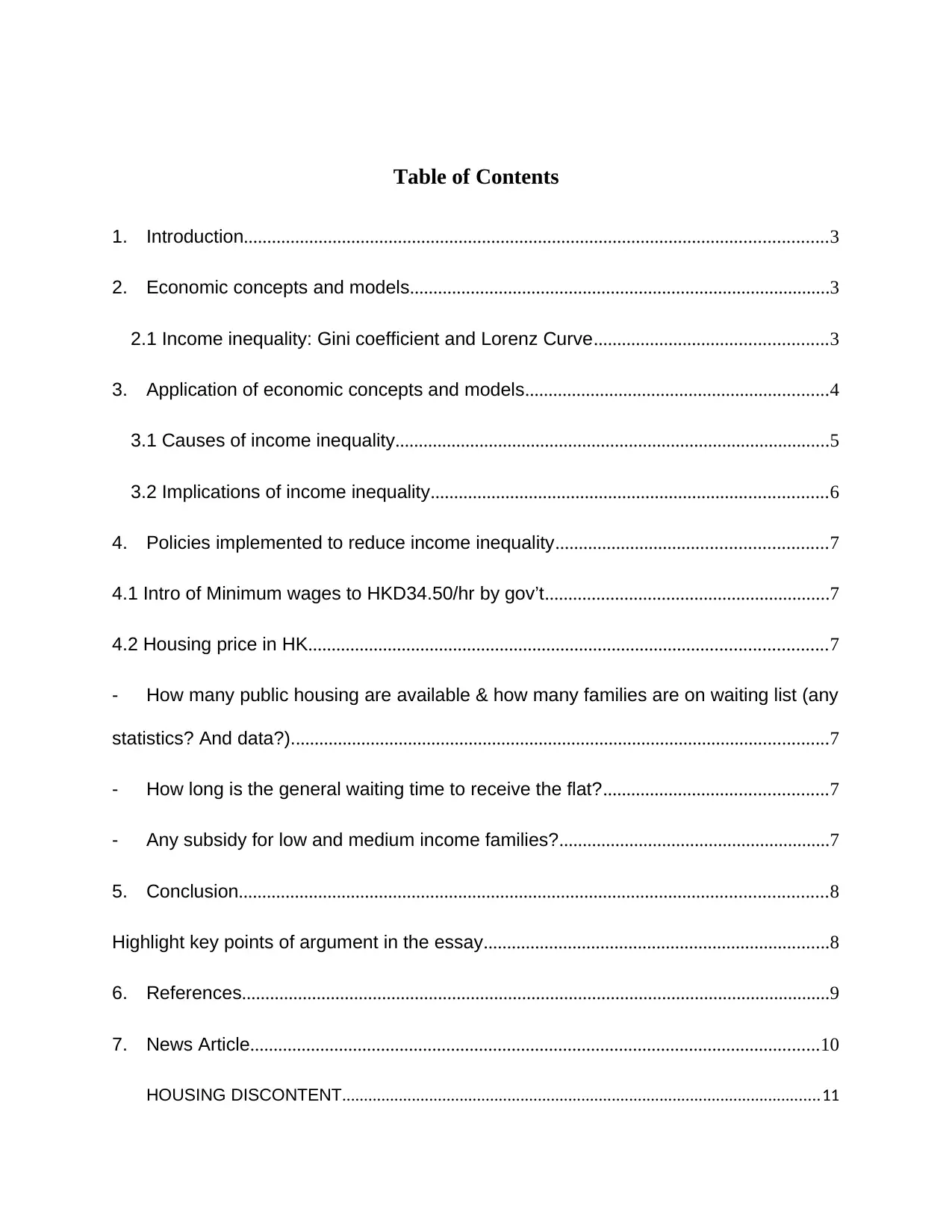
Table of Contents
1. Introduction.............................................................................................................................3
2. Economic concepts and models..........................................................................................3
2.1 Income inequality: Gini coefficient and Lorenz Curve..................................................3
3. Application of economic concepts and models.................................................................4
3.1 Causes of income inequality.............................................................................................5
3.2 Implications of income inequality.....................................................................................6
4. Policies implemented to reduce income inequality..........................................................7
4.1 Intro of Minimum wages to HKD34.50/hr by gov’t.............................................................7
4.2 Housing price in HK...............................................................................................................7
- How many public housing are available & how many families are on waiting list (any
statistics? And data?)...................................................................................................................7
- How long is the general waiting time to receive the flat?................................................7
- Any subsidy for low and medium income families?..........................................................7
5. Conclusion..............................................................................................................................8
Highlight key points of argument in the essay..........................................................................8
6. References..............................................................................................................................9
7. News Article..........................................................................................................................10
HOUSING DISCONTENT..............................................................................................................11
1. Introduction.............................................................................................................................3
2. Economic concepts and models..........................................................................................3
2.1 Income inequality: Gini coefficient and Lorenz Curve..................................................3
3. Application of economic concepts and models.................................................................4
3.1 Causes of income inequality.............................................................................................5
3.2 Implications of income inequality.....................................................................................6
4. Policies implemented to reduce income inequality..........................................................7
4.1 Intro of Minimum wages to HKD34.50/hr by gov’t.............................................................7
4.2 Housing price in HK...............................................................................................................7
- How many public housing are available & how many families are on waiting list (any
statistics? And data?)...................................................................................................................7
- How long is the general waiting time to receive the flat?................................................7
- Any subsidy for low and medium income families?..........................................................7
5. Conclusion..............................................................................................................................8
Highlight key points of argument in the essay..........................................................................8
6. References..............................................................................................................................9
7. News Article..........................................................................................................................10
HOUSING DISCONTENT..............................................................................................................11
⊘ This is a preview!⊘
Do you want full access?
Subscribe today to unlock all pages.

Trusted by 1+ million students worldwide

Paraphrase This Document
Need a fresh take? Get an instant paraphrase of this document with our AI Paraphraser
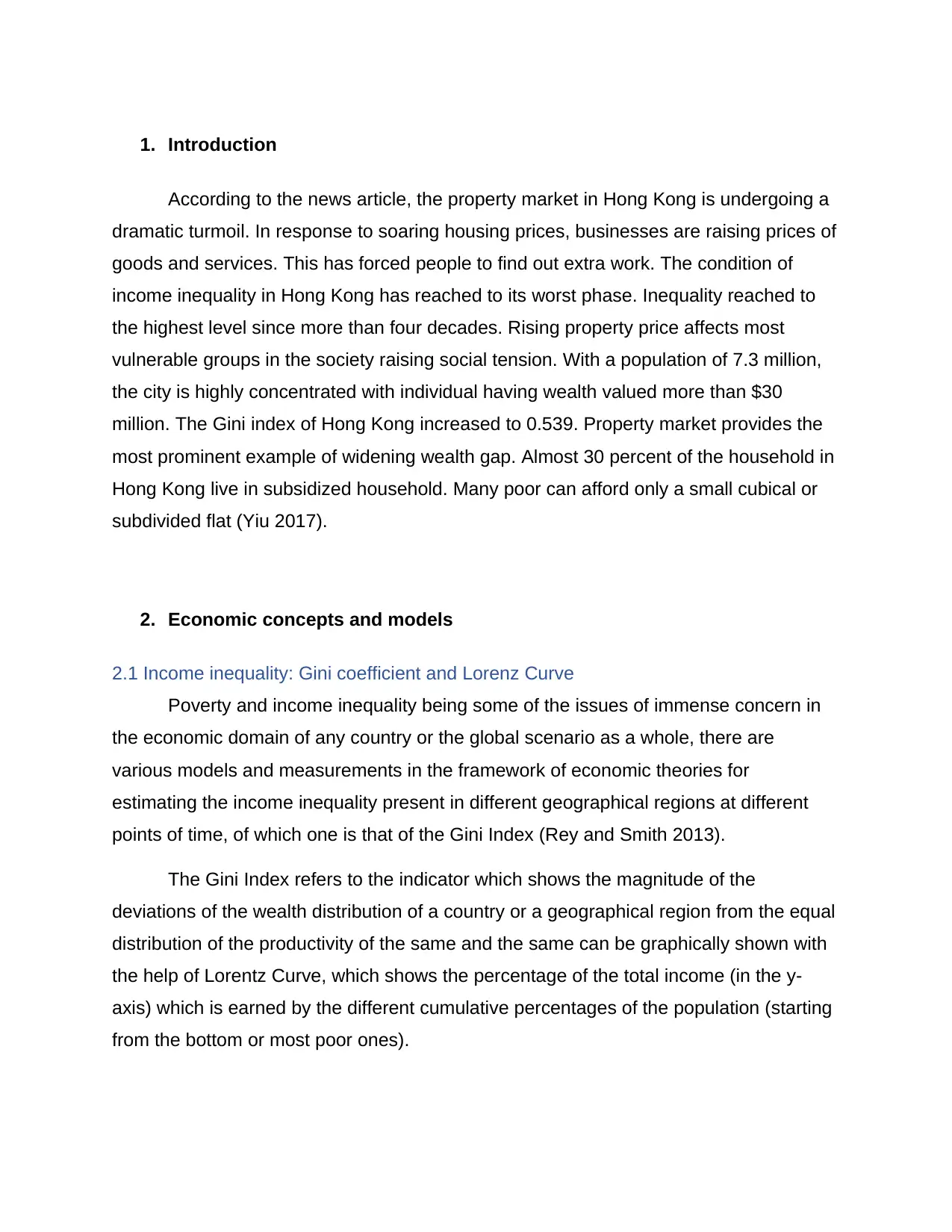
1. Introduction
According to the news article, the property market in Hong Kong is undergoing a
dramatic turmoil. In response to soaring housing prices, businesses are raising prices of
goods and services. This has forced people to find out extra work. The condition of
income inequality in Hong Kong has reached to its worst phase. Inequality reached to
the highest level since more than four decades. Rising property price affects most
vulnerable groups in the society raising social tension. With a population of 7.3 million,
the city is highly concentrated with individual having wealth valued more than $30
million. The Gini index of Hong Kong increased to 0.539. Property market provides the
most prominent example of widening wealth gap. Almost 30 percent of the household in
Hong Kong live in subsidized household. Many poor can afford only a small cubical or
subdivided flat (Yiu 2017).
2. Economic concepts and models
2.1 Income inequality: Gini coefficient and Lorenz Curve
Poverty and income inequality being some of the issues of immense concern in
the economic domain of any country or the global scenario as a whole, there are
various models and measurements in the framework of economic theories for
estimating the income inequality present in different geographical regions at different
points of time, of which one is that of the Gini Index (Rey and Smith 2013).
The Gini Index refers to the indicator which shows the magnitude of the
deviations of the wealth distribution of a country or a geographical region from the equal
distribution of the productivity of the same and the same can be graphically shown with
the help of Lorentz Curve, which shows the percentage of the total income (in the y-
axis) which is earned by the different cumulative percentages of the population (starting
from the bottom or most poor ones).
According to the news article, the property market in Hong Kong is undergoing a
dramatic turmoil. In response to soaring housing prices, businesses are raising prices of
goods and services. This has forced people to find out extra work. The condition of
income inequality in Hong Kong has reached to its worst phase. Inequality reached to
the highest level since more than four decades. Rising property price affects most
vulnerable groups in the society raising social tension. With a population of 7.3 million,
the city is highly concentrated with individual having wealth valued more than $30
million. The Gini index of Hong Kong increased to 0.539. Property market provides the
most prominent example of widening wealth gap. Almost 30 percent of the household in
Hong Kong live in subsidized household. Many poor can afford only a small cubical or
subdivided flat (Yiu 2017).
2. Economic concepts and models
2.1 Income inequality: Gini coefficient and Lorenz Curve
Poverty and income inequality being some of the issues of immense concern in
the economic domain of any country or the global scenario as a whole, there are
various models and measurements in the framework of economic theories for
estimating the income inequality present in different geographical regions at different
points of time, of which one is that of the Gini Index (Rey and Smith 2013).
The Gini Index refers to the indicator which shows the magnitude of the
deviations of the wealth distribution of a country or a geographical region from the equal
distribution of the productivity of the same and the same can be graphically shown with
the help of Lorentz Curve, which shows the percentage of the total income (in the y-
axis) which is earned by the different cumulative percentages of the population (starting
from the bottom or most poor ones).
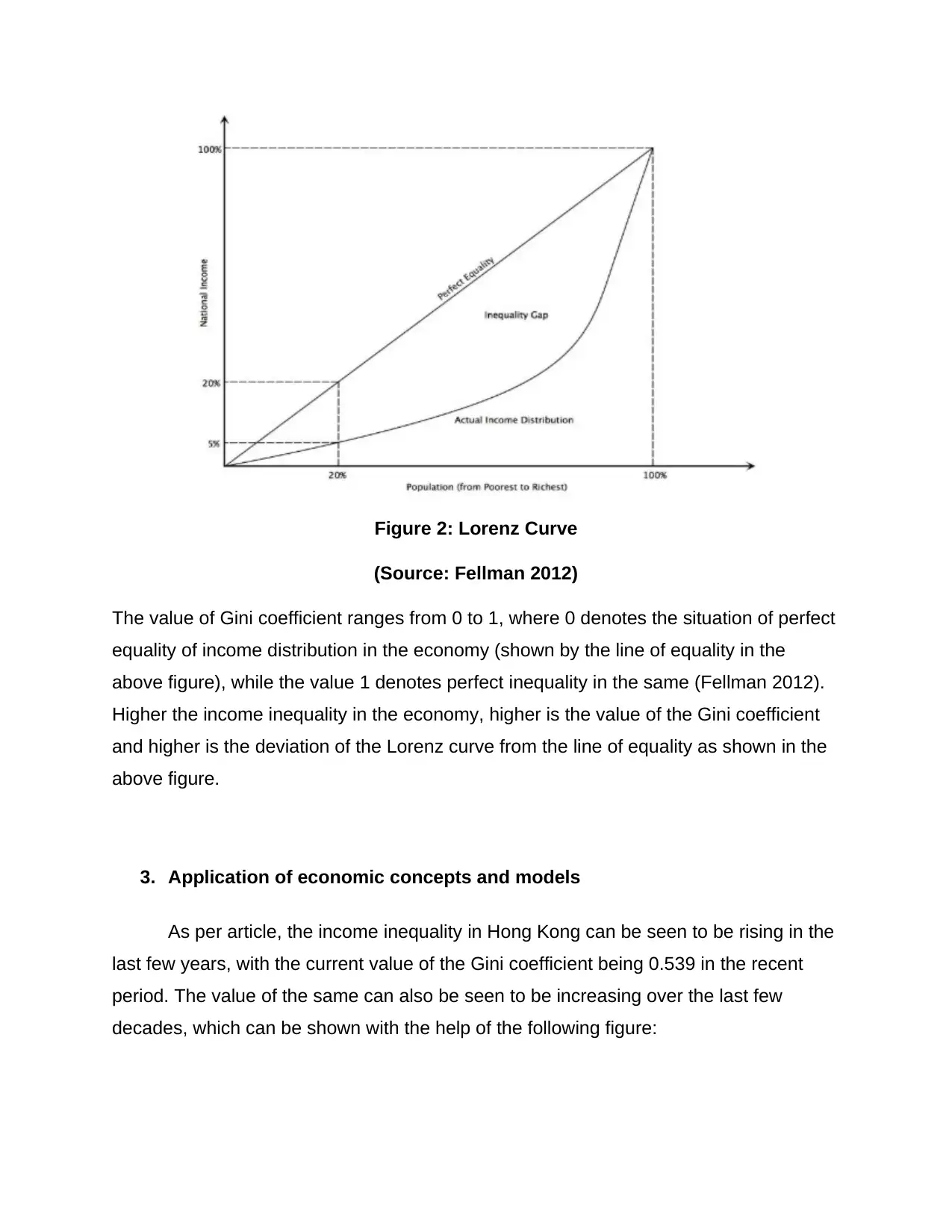
Figure 2: Lorenz Curve
(Source: Fellman 2012)
The value of Gini coefficient ranges from 0 to 1, where 0 denotes the situation of perfect
equality of income distribution in the economy (shown by the line of equality in the
above figure), while the value 1 denotes perfect inequality in the same (Fellman 2012).
Higher the income inequality in the economy, higher is the value of the Gini coefficient
and higher is the deviation of the Lorenz curve from the line of equality as shown in the
above figure.
3. Application of economic concepts and models
As per article, the income inequality in Hong Kong can be seen to be rising in the
last few years, with the current value of the Gini coefficient being 0.539 in the recent
period. The value of the same can also be seen to be increasing over the last few
decades, which can be shown with the help of the following figure:
(Source: Fellman 2012)
The value of Gini coefficient ranges from 0 to 1, where 0 denotes the situation of perfect
equality of income distribution in the economy (shown by the line of equality in the
above figure), while the value 1 denotes perfect inequality in the same (Fellman 2012).
Higher the income inequality in the economy, higher is the value of the Gini coefficient
and higher is the deviation of the Lorenz curve from the line of equality as shown in the
above figure.
3. Application of economic concepts and models
As per article, the income inequality in Hong Kong can be seen to be rising in the
last few years, with the current value of the Gini coefficient being 0.539 in the recent
period. The value of the same can also be seen to be increasing over the last few
decades, which can be shown with the help of the following figure:
⊘ This is a preview!⊘
Do you want full access?
Subscribe today to unlock all pages.

Trusted by 1+ million students worldwide
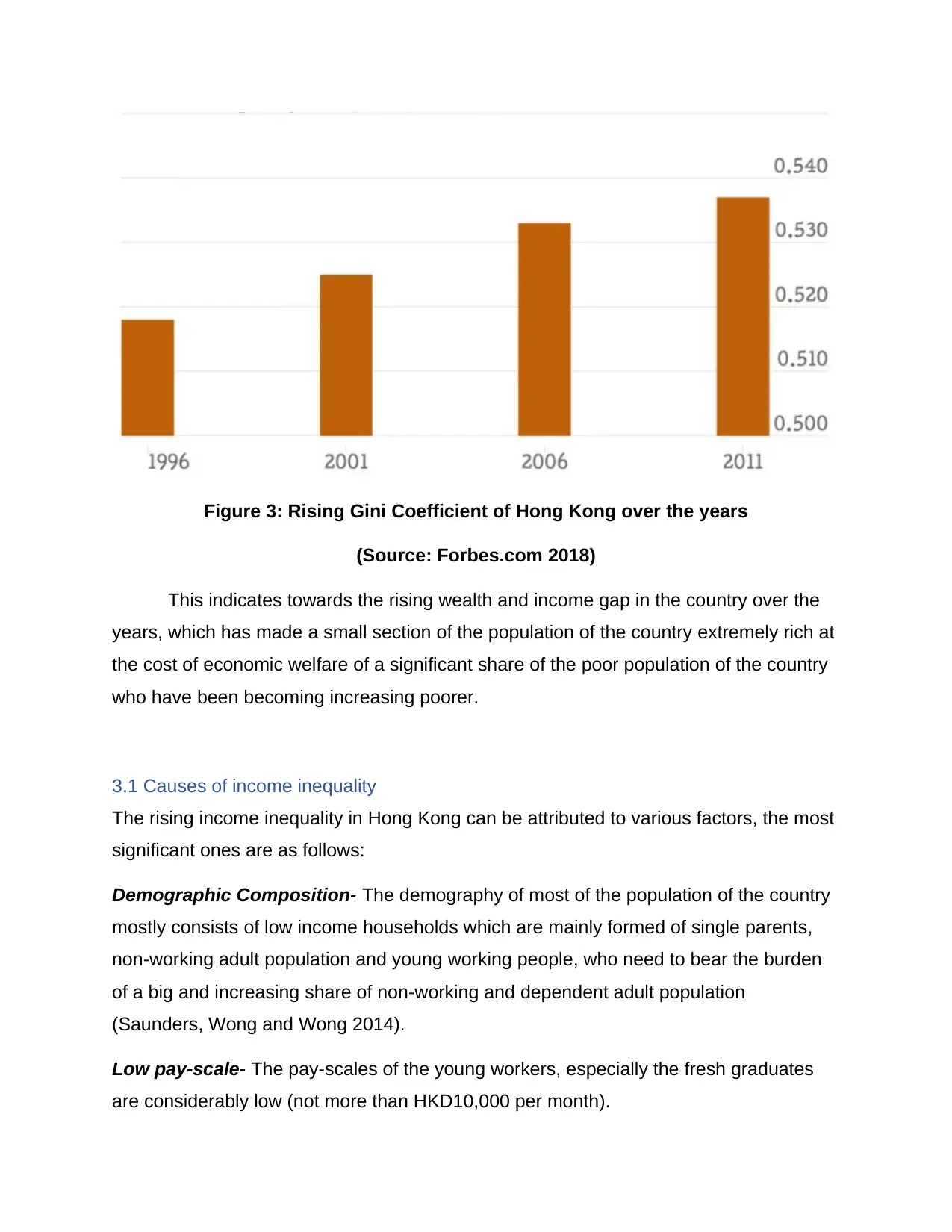
Figure 3: Rising Gini Coefficient of Hong Kong over the years
(Source: Forbes.com 2018)
This indicates towards the rising wealth and income gap in the country over the
years, which has made a small section of the population of the country extremely rich at
the cost of economic welfare of a significant share of the poor population of the country
who have been becoming increasing poorer.
3.1 Causes of income inequality
The rising income inequality in Hong Kong can be attributed to various factors, the most
significant ones are as follows:
Demographic Composition- The demography of most of the population of the country
mostly consists of low income households which are mainly formed of single parents,
non-working adult population and young working people, who need to bear the burden
of a big and increasing share of non-working and dependent adult population
(Saunders, Wong and Wong 2014).
Low pay-scale- The pay-scales of the young workers, especially the fresh graduates
are considerably low (not more than HKD10,000 per month).
(Source: Forbes.com 2018)
This indicates towards the rising wealth and income gap in the country over the
years, which has made a small section of the population of the country extremely rich at
the cost of economic welfare of a significant share of the poor population of the country
who have been becoming increasing poorer.
3.1 Causes of income inequality
The rising income inequality in Hong Kong can be attributed to various factors, the most
significant ones are as follows:
Demographic Composition- The demography of most of the population of the country
mostly consists of low income households which are mainly formed of single parents,
non-working adult population and young working people, who need to bear the burden
of a big and increasing share of non-working and dependent adult population
(Saunders, Wong and Wong 2014).
Low pay-scale- The pay-scales of the young workers, especially the fresh graduates
are considerably low (not more than HKD10,000 per month).
Paraphrase This Document
Need a fresh take? Get an instant paraphrase of this document with our AI Paraphraser
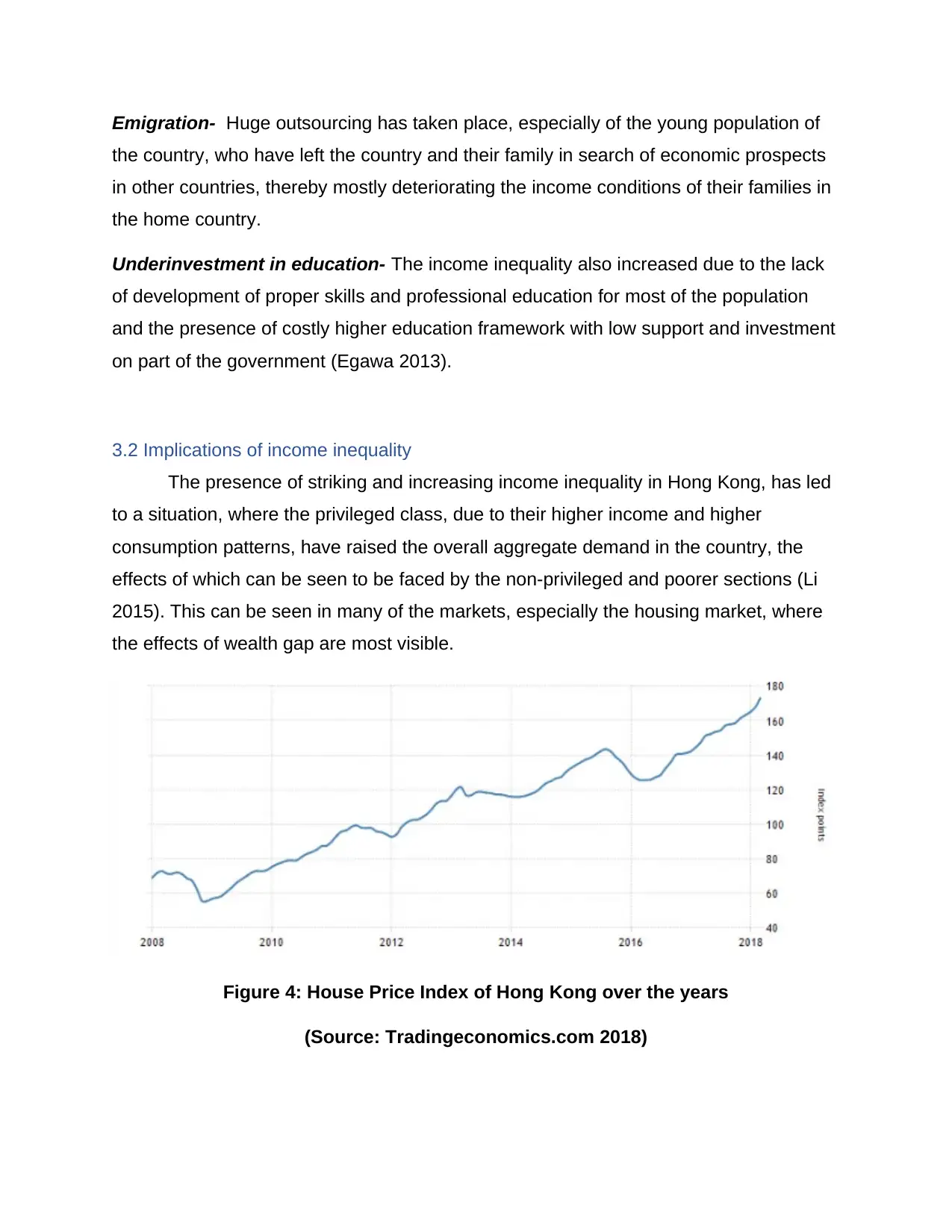
Emigration- Huge outsourcing has taken place, especially of the young population of
the country, who have left the country and their family in search of economic prospects
in other countries, thereby mostly deteriorating the income conditions of their families in
the home country.
Underinvestment in education- The income inequality also increased due to the lack
of development of proper skills and professional education for most of the population
and the presence of costly higher education framework with low support and investment
on part of the government (Egawa 2013).
3.2 Implications of income inequality
The presence of striking and increasing income inequality in Hong Kong, has led
to a situation, where the privileged class, due to their higher income and higher
consumption patterns, have raised the overall aggregate demand in the country, the
effects of which can be seen to be faced by the non-privileged and poorer sections (Li
2015). This can be seen in many of the markets, especially the housing market, where
the effects of wealth gap are most visible.
Figure 4: House Price Index of Hong Kong over the years
(Source: Tradingeconomics.com 2018)
the country, who have left the country and their family in search of economic prospects
in other countries, thereby mostly deteriorating the income conditions of their families in
the home country.
Underinvestment in education- The income inequality also increased due to the lack
of development of proper skills and professional education for most of the population
and the presence of costly higher education framework with low support and investment
on part of the government (Egawa 2013).
3.2 Implications of income inequality
The presence of striking and increasing income inequality in Hong Kong, has led
to a situation, where the privileged class, due to their higher income and higher
consumption patterns, have raised the overall aggregate demand in the country, the
effects of which can be seen to be faced by the non-privileged and poorer sections (Li
2015). This can be seen in many of the markets, especially the housing market, where
the effects of wealth gap are most visible.
Figure 4: House Price Index of Hong Kong over the years
(Source: Tradingeconomics.com 2018)
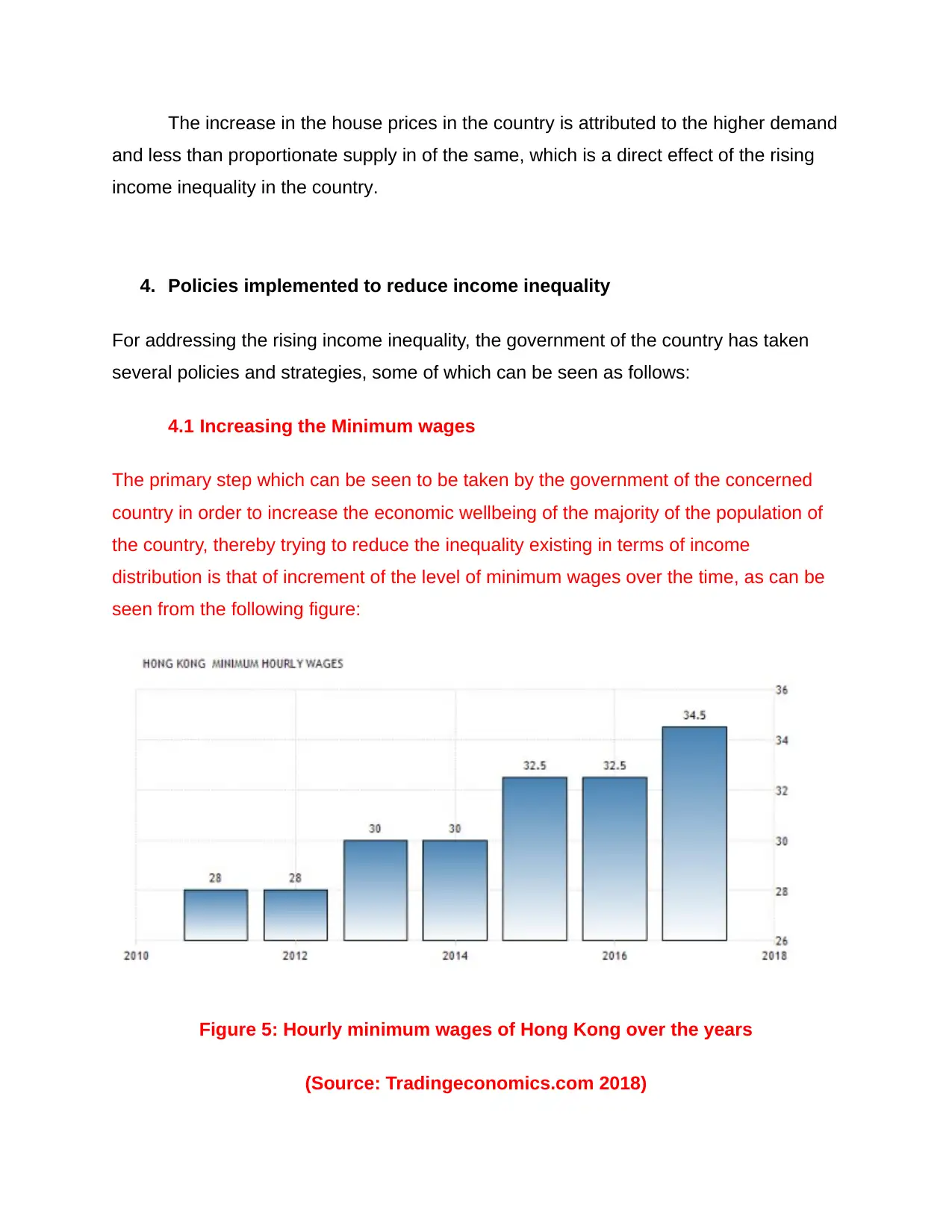
The increase in the house prices in the country is attributed to the higher demand
and less than proportionate supply in of the same, which is a direct effect of the rising
income inequality in the country.
4. Policies implemented to reduce income inequality
For addressing the rising income inequality, the government of the country has taken
several policies and strategies, some of which can be seen as follows:
4.1 Increasing the Minimum wages
The primary step which can be seen to be taken by the government of the concerned
country in order to increase the economic wellbeing of the majority of the population of
the country, thereby trying to reduce the inequality existing in terms of income
distribution is that of increment of the level of minimum wages over the time, as can be
seen from the following figure:
Figure 5: Hourly minimum wages of Hong Kong over the years
(Source: Tradingeconomics.com 2018)
and less than proportionate supply in of the same, which is a direct effect of the rising
income inequality in the country.
4. Policies implemented to reduce income inequality
For addressing the rising income inequality, the government of the country has taken
several policies and strategies, some of which can be seen as follows:
4.1 Increasing the Minimum wages
The primary step which can be seen to be taken by the government of the concerned
country in order to increase the economic wellbeing of the majority of the population of
the country, thereby trying to reduce the inequality existing in terms of income
distribution is that of increment of the level of minimum wages over the time, as can be
seen from the following figure:
Figure 5: Hourly minimum wages of Hong Kong over the years
(Source: Tradingeconomics.com 2018)
⊘ This is a preview!⊘
Do you want full access?
Subscribe today to unlock all pages.

Trusted by 1+ million students worldwide
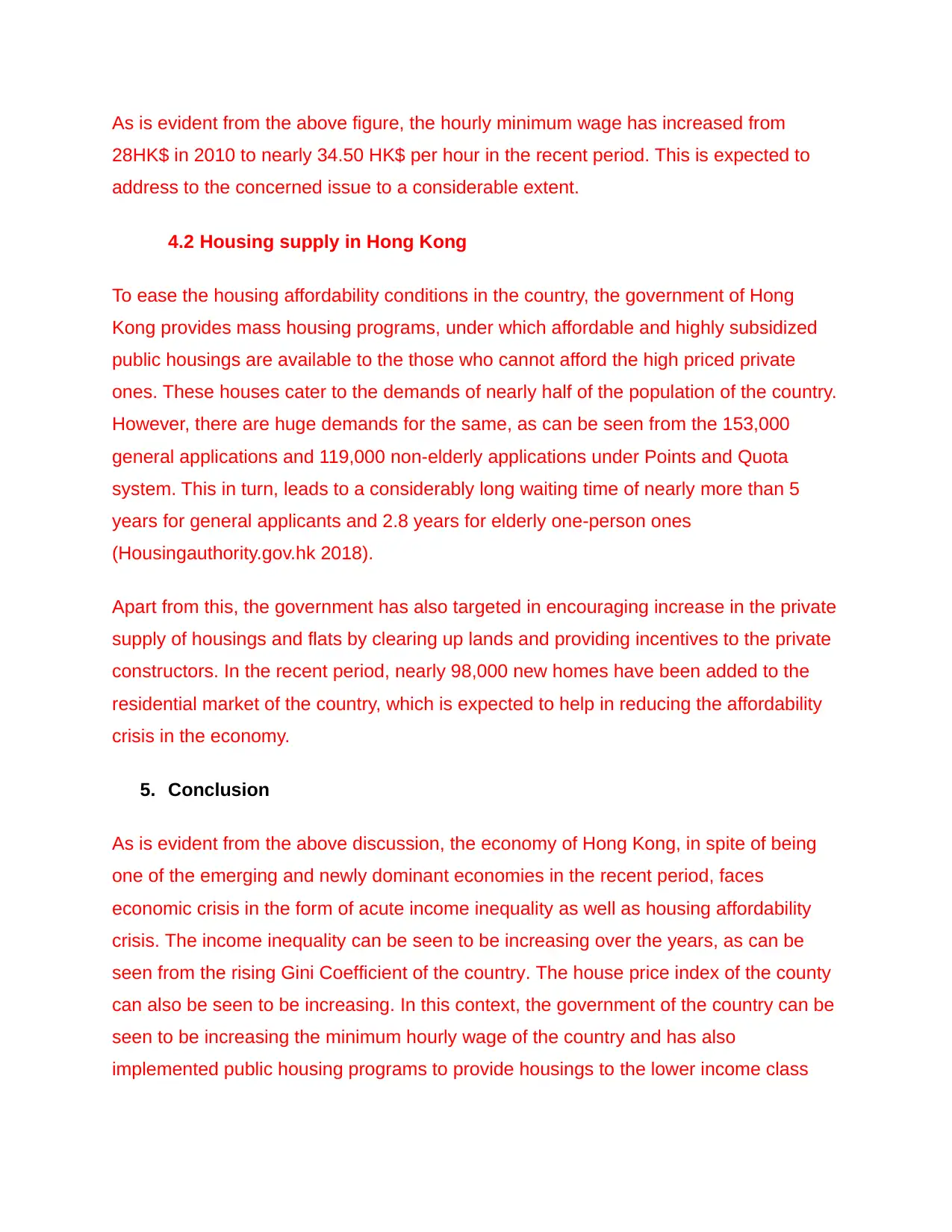
As is evident from the above figure, the hourly minimum wage has increased from
28HK$ in 2010 to nearly 34.50 HK$ per hour in the recent period. This is expected to
address to the concerned issue to a considerable extent.
4.2 Housing supply in Hong Kong
To ease the housing affordability conditions in the country, the government of Hong
Kong provides mass housing programs, under which affordable and highly subsidized
public housings are available to the those who cannot afford the high priced private
ones. These houses cater to the demands of nearly half of the population of the country.
However, there are huge demands for the same, as can be seen from the 153,000
general applications and 119,000 non-elderly applications under Points and Quota
system. This in turn, leads to a considerably long waiting time of nearly more than 5
years for general applicants and 2.8 years for elderly one-person ones
(Housingauthority.gov.hk 2018).
Apart from this, the government has also targeted in encouraging increase in the private
supply of housings and flats by clearing up lands and providing incentives to the private
constructors. In the recent period, nearly 98,000 new homes have been added to the
residential market of the country, which is expected to help in reducing the affordability
crisis in the economy.
5. Conclusion
As is evident from the above discussion, the economy of Hong Kong, in spite of being
one of the emerging and newly dominant economies in the recent period, faces
economic crisis in the form of acute income inequality as well as housing affordability
crisis. The income inequality can be seen to be increasing over the years, as can be
seen from the rising Gini Coefficient of the country. The house price index of the county
can also be seen to be increasing. In this context, the government of the country can be
seen to be increasing the minimum hourly wage of the country and has also
implemented public housing programs to provide housings to the lower income class
28HK$ in 2010 to nearly 34.50 HK$ per hour in the recent period. This is expected to
address to the concerned issue to a considerable extent.
4.2 Housing supply in Hong Kong
To ease the housing affordability conditions in the country, the government of Hong
Kong provides mass housing programs, under which affordable and highly subsidized
public housings are available to the those who cannot afford the high priced private
ones. These houses cater to the demands of nearly half of the population of the country.
However, there are huge demands for the same, as can be seen from the 153,000
general applications and 119,000 non-elderly applications under Points and Quota
system. This in turn, leads to a considerably long waiting time of nearly more than 5
years for general applicants and 2.8 years for elderly one-person ones
(Housingauthority.gov.hk 2018).
Apart from this, the government has also targeted in encouraging increase in the private
supply of housings and flats by clearing up lands and providing incentives to the private
constructors. In the recent period, nearly 98,000 new homes have been added to the
residential market of the country, which is expected to help in reducing the affordability
crisis in the economy.
5. Conclusion
As is evident from the above discussion, the economy of Hong Kong, in spite of being
one of the emerging and newly dominant economies in the recent period, faces
economic crisis in the form of acute income inequality as well as housing affordability
crisis. The income inequality can be seen to be increasing over the years, as can be
seen from the rising Gini Coefficient of the country. The house price index of the county
can also be seen to be increasing. In this context, the government of the country can be
seen to be increasing the minimum hourly wage of the country and has also
implemented public housing programs to provide housings to the lower income class
Paraphrase This Document
Need a fresh take? Get an instant paraphrase of this document with our AI Paraphraser
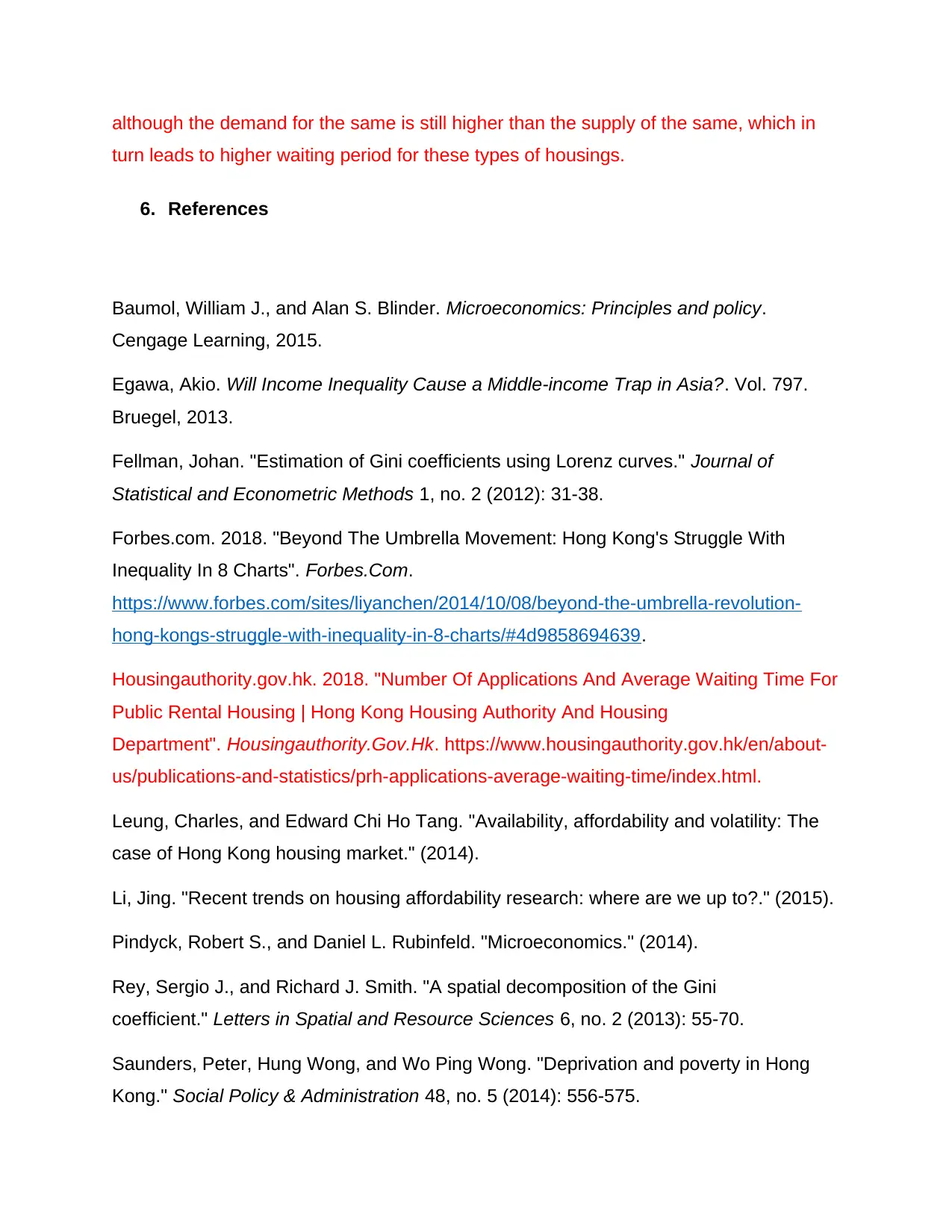
although the demand for the same is still higher than the supply of the same, which in
turn leads to higher waiting period for these types of housings.
6. References
Baumol, William J., and Alan S. Blinder. Microeconomics: Principles and policy.
Cengage Learning, 2015.
Egawa, Akio. Will Income Inequality Cause a Middle-income Trap in Asia?. Vol. 797.
Bruegel, 2013.
Fellman, Johan. "Estimation of Gini coefficients using Lorenz curves." Journal of
Statistical and Econometric Methods 1, no. 2 (2012): 31-38.
Forbes.com. 2018. "Beyond The Umbrella Movement: Hong Kong's Struggle With
Inequality In 8 Charts". Forbes.Com.
https://www.forbes.com/sites/liyanchen/2014/10/08/beyond-the-umbrella-revolution-
hong-kongs-struggle-with-inequality-in-8-charts/#4d9858694639.
Housingauthority.gov.hk. 2018. "Number Of Applications And Average Waiting Time For
Public Rental Housing | Hong Kong Housing Authority And Housing
Department". Housingauthority.Gov.Hk. https://www.housingauthority.gov.hk/en/about-
us/publications-and-statistics/prh-applications-average-waiting-time/index.html.
Leung, Charles, and Edward Chi Ho Tang. "Availability, affordability and volatility: The
case of Hong Kong housing market." (2014).
Li, Jing. "Recent trends on housing affordability research: where are we up to?." (2015).
Pindyck, Robert S., and Daniel L. Rubinfeld. "Microeconomics." (2014).
Rey, Sergio J., and Richard J. Smith. "A spatial decomposition of the Gini
coefficient." Letters in Spatial and Resource Sciences 6, no. 2 (2013): 55-70.
Saunders, Peter, Hung Wong, and Wo Ping Wong. "Deprivation and poverty in Hong
Kong." Social Policy & Administration 48, no. 5 (2014): 556-575.
turn leads to higher waiting period for these types of housings.
6. References
Baumol, William J., and Alan S. Blinder. Microeconomics: Principles and policy.
Cengage Learning, 2015.
Egawa, Akio. Will Income Inequality Cause a Middle-income Trap in Asia?. Vol. 797.
Bruegel, 2013.
Fellman, Johan. "Estimation of Gini coefficients using Lorenz curves." Journal of
Statistical and Econometric Methods 1, no. 2 (2012): 31-38.
Forbes.com. 2018. "Beyond The Umbrella Movement: Hong Kong's Struggle With
Inequality In 8 Charts". Forbes.Com.
https://www.forbes.com/sites/liyanchen/2014/10/08/beyond-the-umbrella-revolution-
hong-kongs-struggle-with-inequality-in-8-charts/#4d9858694639.
Housingauthority.gov.hk. 2018. "Number Of Applications And Average Waiting Time For
Public Rental Housing | Hong Kong Housing Authority And Housing
Department". Housingauthority.Gov.Hk. https://www.housingauthority.gov.hk/en/about-
us/publications-and-statistics/prh-applications-average-waiting-time/index.html.
Leung, Charles, and Edward Chi Ho Tang. "Availability, affordability and volatility: The
case of Hong Kong housing market." (2014).
Li, Jing. "Recent trends on housing affordability research: where are we up to?." (2015).
Pindyck, Robert S., and Daniel L. Rubinfeld. "Microeconomics." (2014).
Rey, Sergio J., and Richard J. Smith. "A spatial decomposition of the Gini
coefficient." Letters in Spatial and Resource Sciences 6, no. 2 (2013): 55-70.
Saunders, Peter, Hung Wong, and Wo Ping Wong. "Deprivation and poverty in Hong
Kong." Social Policy & Administration 48, no. 5 (2014): 556-575.
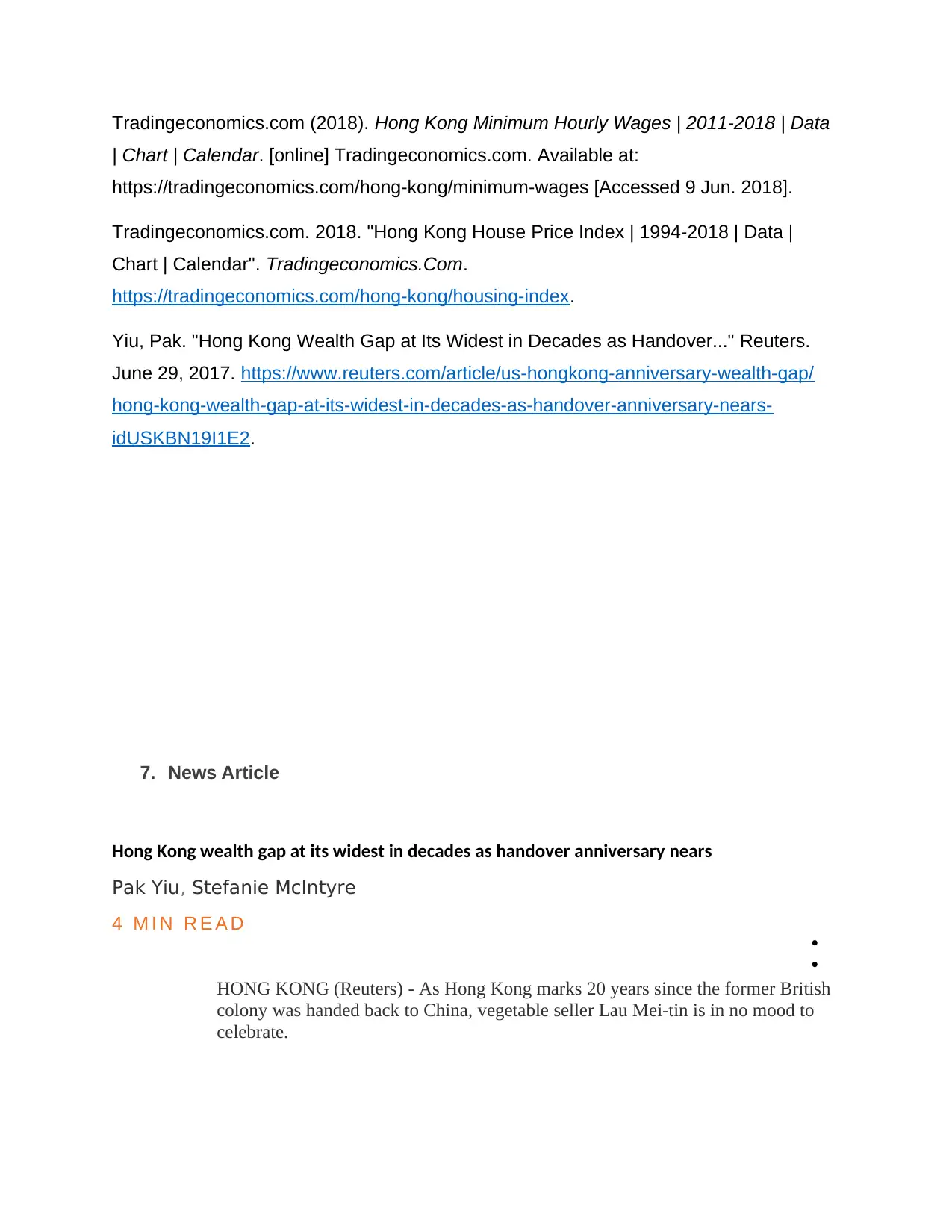
Tradingeconomics.com (2018). Hong Kong Minimum Hourly Wages | 2011-2018 | Data
| Chart | Calendar. [online] Tradingeconomics.com. Available at:
https://tradingeconomics.com/hong-kong/minimum-wages [Accessed 9 Jun. 2018].
Tradingeconomics.com. 2018. "Hong Kong House Price Index | 1994-2018 | Data |
Chart | Calendar". Tradingeconomics.Com.
https://tradingeconomics.com/hong-kong/housing-index.
Yiu, Pak. "Hong Kong Wealth Gap at Its Widest in Decades as Handover..." Reuters.
June 29, 2017. https://www.reuters.com/article/us-hongkong-anniversary-wealth-gap/
hong-kong-wealth-gap-at-its-widest-in-decades-as-handover-anniversary-nears-
idUSKBN19I1E2.
7. News Article
Hong Kong wealth gap at its widest in decades as handover anniversary nears
Pak Yiu, Stefanie McIntyre
4 M I N R E A D
HONG KONG (Reuters) - As Hong Kong marks 20 years since the former British
colony was handed back to China, vegetable seller Lau Mei-tin is in no mood to
celebrate.
| Chart | Calendar. [online] Tradingeconomics.com. Available at:
https://tradingeconomics.com/hong-kong/minimum-wages [Accessed 9 Jun. 2018].
Tradingeconomics.com. 2018. "Hong Kong House Price Index | 1994-2018 | Data |
Chart | Calendar". Tradingeconomics.Com.
https://tradingeconomics.com/hong-kong/housing-index.
Yiu, Pak. "Hong Kong Wealth Gap at Its Widest in Decades as Handover..." Reuters.
June 29, 2017. https://www.reuters.com/article/us-hongkong-anniversary-wealth-gap/
hong-kong-wealth-gap-at-its-widest-in-decades-as-handover-anniversary-nears-
idUSKBN19I1E2.
7. News Article
Hong Kong wealth gap at its widest in decades as handover anniversary nears
Pak Yiu, Stefanie McIntyre
4 M I N R E A D
HONG KONG (Reuters) - As Hong Kong marks 20 years since the former British
colony was handed back to China, vegetable seller Lau Mei-tin is in no mood to
celebrate.
⊘ This is a preview!⊘
Do you want full access?
Subscribe today to unlock all pages.

Trusted by 1+ million students worldwide
1 out of 15
Your All-in-One AI-Powered Toolkit for Academic Success.
+13062052269
info@desklib.com
Available 24*7 on WhatsApp / Email
![[object Object]](/_next/static/media/star-bottom.7253800d.svg)
Unlock your academic potential
Copyright © 2020–2025 A2Z Services. All Rights Reserved. Developed and managed by ZUCOL.


